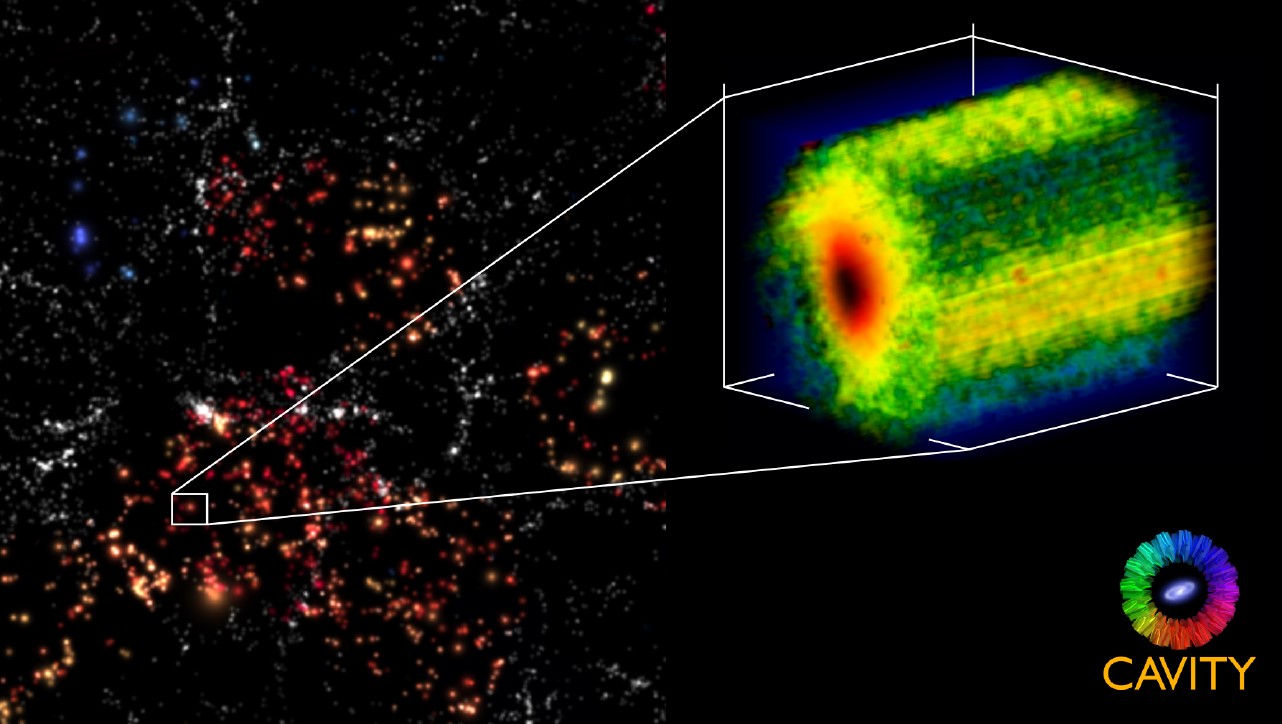The IAA-CSIC participates in a project that offers the scientific community three-dimensional images of 100 galaxies
CAVITY is the name of this international initiative whose objective is to monitor up to 400 galaxies in the future to learn about their formation and evolution
The CAVITY project, led by the University of Granada, and with an important participation of the Instituto de Astrofísica de Andalucía (IAA-CSIC), launches its first public distribution of data, which means offering the scientific community spectroscopic information covering the two-dimensional extent (data cubes) of 100 galaxies. This is the only 3D mapping of galaxies in cosmic voids, i.e., those in whose interior there is almost no mass.
A PIONEERING PROJECT TO UNDERSTAND LARGE-SCALE STRUCTURE
Galaxies are not randomly distributed in the universe, but form a filamentary sponge-like structure, following the distribution of dark matter. This gives rise to large clusters of galaxies in which the density is such that interactions and collisions are frequent. There are also regions inside which there is hardly any mass, which present a more pristine environment, free of the large interactions of the clusters. The latter, the so-called cosmic voids, are the regions studied by CAVITY.
CAVITY is a pioneering project that seeks to understand the role of the large-scale structure of the universe in the formation and evolution of galaxies, studying in detail the systems that inhabit these cosmic voids.
The base of the initiative is the Calar Alto observatory, in Almería, which is obtaining data with the PMAS/PPAK instrument of the 3.5-meter telescope, in addition to data from other large astronomical infrastructures. "Its ultimate goal is to achieve unprecedentedly varied and crucial data for 400 galaxies in cosmic voids," explains Isabel Pérez Martín, professor at the Department of Theoretical and Cosmos Physics of the UGR who is working on this project. CAVITY involves 50 researchers from 13 national and international institutions and is led by the University of Granada.

CAVITY Project. Credit: CAVITY Collaboration
The first public distribution of data includes the optical range integral field spectroscopy (PMAS/PPAK V500) cubes of 100 galaxies inhabiting cosmological voids in the local universe. "This first public distribution of data provides an unprecedented basis for the detailed study of galaxies in cosmological voids, which will allow researchers to explore a wide range of properties of this type of galaxies," details Rubén García Benito, IAA-CSIC researcher and CAVITY Project Data Scientist. "The IAA-CSIC is internationally recognized in the complex processing of integral field spectroscopy data. Our extensive experience in previous mapping has allowed us to process the best data observed from Calar Alto", says the researcher.
"This information allows us to cover a wide range of galaxy properties, including brightness, color, mass and morphology," concludes UGR professor Isabel Pérez.
UNIVERSAL LEGACY
Access to the database is available on the project website, which encourages collaboration and knowledge sharing among researchers, although its legacy nature extends beyond professionals, and anyone interested will be able to access the data.
For more information on the first CAVITY data release: https://cavity.caha.es
CAVITY está financiado por MICIN/AEI a través del proyecto PID2020-113689GB-100, la Consejería de Universidad, Investigación e Innovación de la Junta de Andalucía, el Gobierno de España, la Unión Europea –- NextGenerationEU a través de AST22.4.4 y la Universidad de Granada.
Instituto de Astrofísica de Andalucía (IAA-CSIC)
Unidad de Divulgación y Comunicación
Emilio J. García - garcia@iaa.es - 649 407 445
https://www.iaa.csic.es
https://divulgacion.iaa.csic.es

